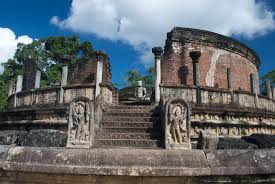Directory
Pulasthipura / Polonnaruwa
Mahawamsa and Culavamsa speak of Pulasthipura; the early historical name of Polonnaruwa; a UNESCO world heritage site, has a great history of conquest and struggle behind it and rightfully forms the third element in the Cultural Triangle. Located about 140 kms north east from Kandy, Polonnaruwa offers hours of endless pleasure for history and culture lovers, as there are numerous sights of significance.
Polonnaruwa became the capital of Sri Lanka subsequent to the decline of Anuradhapura and witnessed the Sinhala Buddhist civilization reaching much greater heights. The vast irrigation network with reservoirs that looks like inland seas sustained such classic balance in rice cultivation, during the rule of King Parakramabahu the Great (1153-1186 AD) and Sri Lanka came to be known as the Granary of the Orient. The main attractions are the conserved ruins of glorious royal palaces, massive Buddhist temples, and unbroken monuments in colossal statues carved from sold rock boulders.
Polonnaruwa, with its conserved ruins and renovated ancient irrigation reservoirs is a “must visit” destination of Sri Lanka. As much as the conserved cultural monuments would enlighten the tourists, the wild life sanctuaries in the district of Polonnaruwa affords ample opportunities for the joy and fun in the close range of wild elephants, other mammals to the lovers of wildlife. At the city of Polonnaruwa the largest ancient irrigation reservoir called Parakrama Samudra (the Sea of Parakrama) which is always lovely, and with the excess of birdlife, it is seldom that there is not something interesting going on upon its shimmering expanses of waters.
Polonnaruwa is located in between Wildlife at Minneriya National Park, Wasgamuwa National Park, Kaudulla National Park and Eco Hotels at Kandalama & Habarana.











